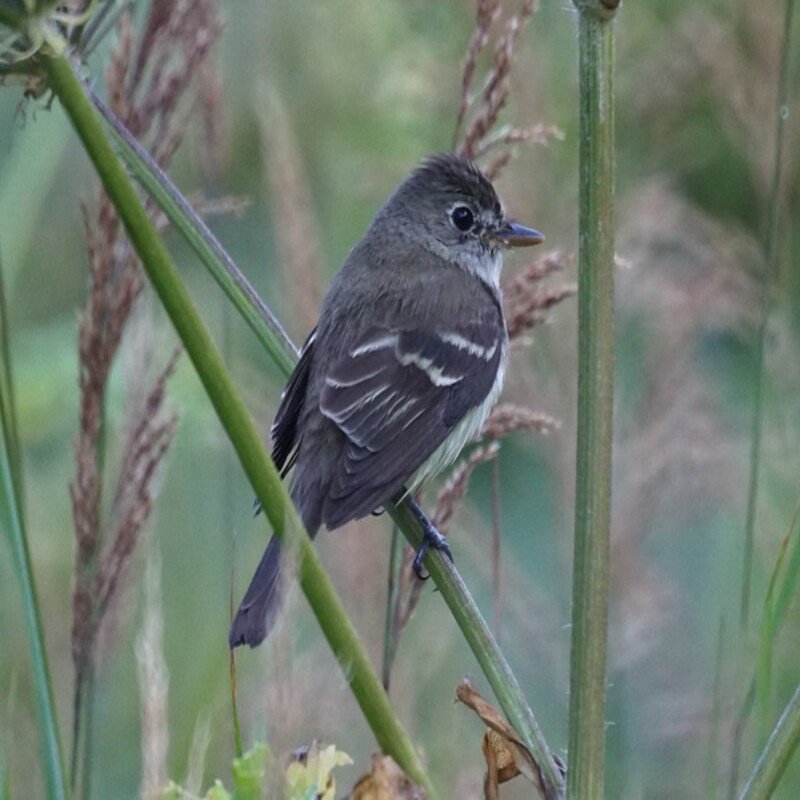The alder flycatcher, Empidonax alnorum is a small insectivorous bird belonging to the family of tyrant flycatchers. Empidonax derives from the Ancient Greek empis, “gnat,” and anax, “master.” The specific epithet alnorum is Latin for “of the alders.”
Quick Overview: Empidonax Alnorum – Alder Flycatcher
Body size: Around 5.75 in (15 cm) and a weight of 14 g (0.5 oz)
Main colors: Olive-brown, White, Orange, Black
Range: Eastern United States
Migratory Bird: Yes
Best time of the year to see in the U.S.: March, April, May, September, October, November
Conservation Status: Least Concern
Alder flycatcher Description
Olive-brown upperparts, white underparts, and a faint white eye-ring characterize this little flycatcher. Olive-brown wings with two white or pale bands. Short bill with an orange lower mandible. Legs and feet in black.

Size
These birds have a length of 5.75 in (15 cm) and a weight of 14 g (0.5 oz). Their wings could range from 8-9 in (20-23 cm).
Feeding
Primarily insects. Summer diet consists primarily of insects, which includes a large number of small wasps, winged ants, beetles, caterpillars, midges, and flies, as well as a few real bugs, grasshoppers, and others. Additionally, eats spiders and, on infrequently, a few berries.
Habitat
As its name implies, the Alder Flycatcher is frequently found in dense stands of alder and birch near riparian regions and along the edges of swamps, bogs, and ponds. These birds forage in the airspace beneath the canopy of tall alder trees found in wetlands and along waterways.
Behavior
The alder flycatcher’s vocalizations are quite important for field identification. The song is a characteristic “fee-bee-o”; birds have been spotted singing with their heads thrown back and tails shook. E. alnorum produces a variety of calls, the most common of which is a “pit” sound made while foraging. Other calls include those indicative of aggressive or territorial activity, such as the “double-peak,” “zwee-oo,” and “wee-oo” cries, as well as those indicative of enthusiasm, such as the “kitter” call. The alder flycatcher breeds in moist alder, maple, and birch thickets.
Empidonax Alnorum Scientific Classification
- Kingdom: Animalia
- Phylum: Chordata
- Subphylum: Chelicerata
- Class: Aves
- Order: Passeriformes
- Family: Tyrannidae
- Genus: Empidonax
- Species: Empidonax alnorum
Best time of the year to see
In the United States, the best time of year to see these birds are during the Spring season (March-May) and during the Autumn season (September – November).
Distribution of the Alder flycatcher in the USA
Breeds from Alaska, to Newfoundland, then south to British Columbia, the Great Lakes region, much of New England, and the Mid-Atlantic regions. Winters in the tropics.
The Alder flycatcher can be found in the following states in the United States – Alabama, Arkansas, Colorado, Connecticut, Delaware, Florida, Georgia, Hawaii, Illinois, Indiana, Iowa, Kansas, Kentucky, Louisiana, Maine, Maryland, Massachusetts, Michigan, Minnesota, Mississippi, Missouri, Montana, Nebraska, New Hampshire, New Jersey, New Mexico, New York, North Carolina, North Dakota, Ohio, Oklahoma, Pennsylvania, Rhode Island, South Carolina, South Dakota, Tennessee, Texas, Utah, Vermont, Virginia, West Virginia, Wisconsin, and Wyoming.
